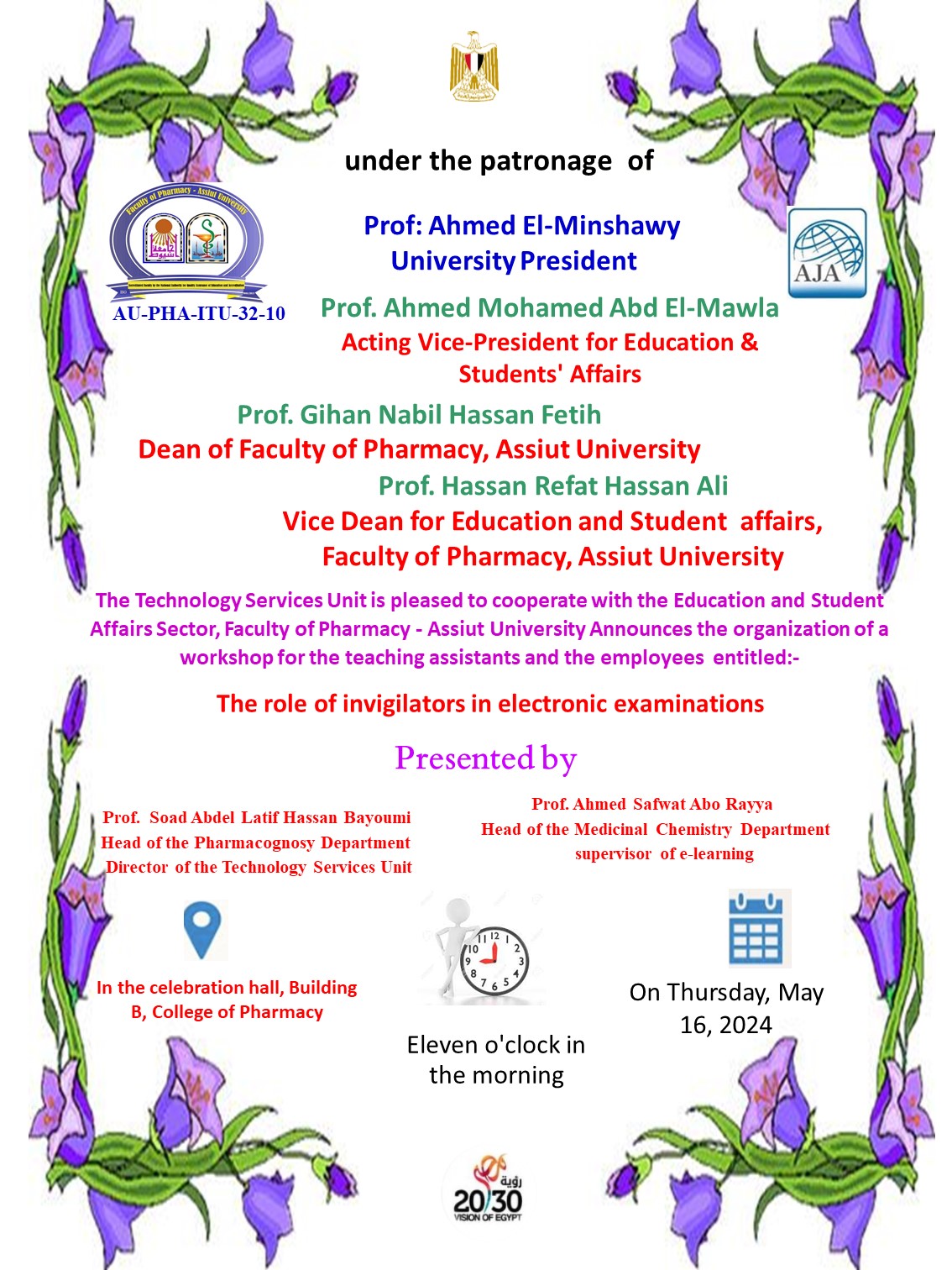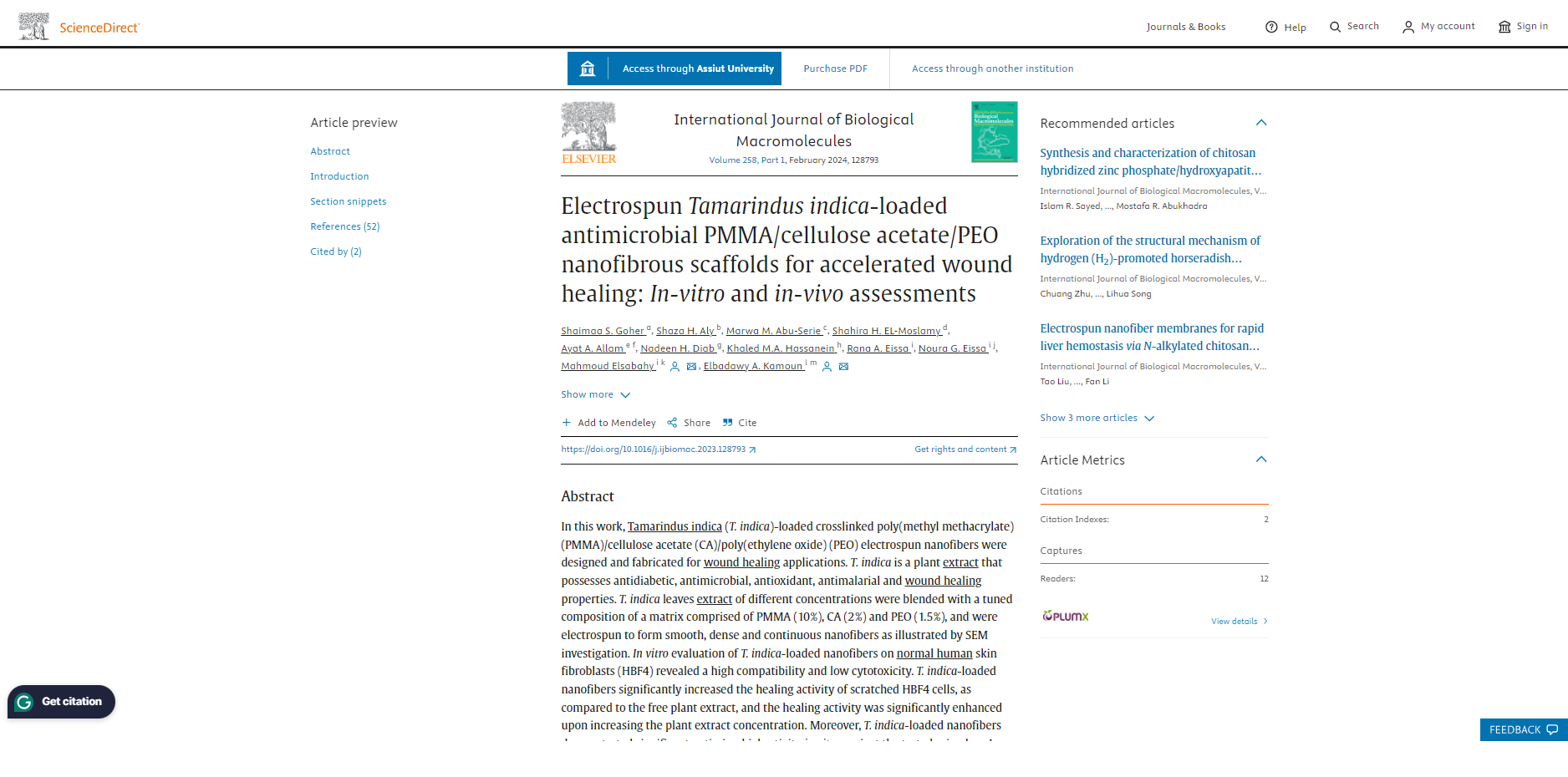

 Do you have any questions? (088) 2080369 - 2345622 Pharmacy_QAAU@pharm.aun.edu.eg
Do you have any questions? (088) 2080369 - 2345622 Pharmacy_QAAU@pharm.aun.edu.eg
The Technology Services Unit, in cooperation with the Education and Student Affairs Sector at the Faculty of Pharmacy - Assiut University, is pleased to announce the organization of a workshop for the teaching assistants and the employees entitled: - The
Thesis defense of the pharmacist/ Doaa Hassan Rushdi - teaching assistant at the Faculty of Pharmacy, Sohag University, registered for the Master’s degree in Pharmaceutical Sciences (Pharmaceutical Analytical Chemistry) on Wednesday, May 15, 2024.
Practical result for first-year students in Pharmacognosy-1course

Announcement to students of the Clinical Pharmacy Program who wishes to submit a petition to examine the practical grade for Medicinal Plants, the offered course

Anyone who wishes to submit a petition for a (practical) grade examination must register his name with the department’s secretariat starting Tuesday, May 14, 2024, until Monday, May 20, 2024.
The result of examining the petitions will be announced on Tuesday, May 21, 2024, for students who registered their names in the department’s secretariat.
Thesis defense of the pharmacist/ Reem Mohamed Mohamed Ahmed - registered for a master’s degree in pharmaceutical sciences (Microbiology and Immunology) on Tuesday, May 14, 2024
Practical result for students of the clinical pharmacy program, medicinal plants offered course


Announcement for students of the Clinical Pharmacy Program: An oral exam will be held for semester (8), an elective course (tissue metabolism)

The Department of Biochemistry - Faculty of Pharmacy has decided to hold the oral exam for the students of Semester (8) of the elective course (Tissue Metabolism) on Saturday, 5/25/2024. 2 pm before the Final exam.
Electrospun Tamarindus indica-loaded antimicrobial PMMA/cellulose acetate/PEO nanofibrous scaffolds for accelerated wound healing: In-vitro and in-vivo assessments
In this work, Tamarindus indica (T. indica)-loaded crosslinked poly(methyl methacrylate) (PMMA)/cellulose acetate (CA)/poly(ethylene oxide) (PEO) electrospun nanofibers were designed and fabricated for wound healing applications. T. indica is a plant extract that possesses antidiabetic, antimicrobial, antioxidant, antimalarial and wound healing properties. T. indica leaves extract of different concentrations were blended with a tuned composition of a matrix comprised of PMMA (10 %), CA (2 %) and PEO (1.5 %), and were electrospun to form smooth, dense and continuous nanofibers as illustrated by SEM investigation. In vitro evaluation of T. indica-loaded nanofibers on normal human skin fibroblasts (HBF4) revealed a high compatibility and low cytotoxicity. T. indica-loaded nanofibers significantly increased the healing activity of scratched HBF4 cells, as compared to the free plant extract, and the healing activity was significantly enhanced upon increasing the plant extract concentration. Moreover, T. indica-loaded nanofibers demonstrated significant antimicrobial activity in vitro against the tested microbes. In vivo, nanofibers resulted in a superior wound healing efficiency compared to the control untreated animals. Hence, engineered nanofibers loaded with potent phytochemicals could be exploited as an effective biocompatible and eco-friendly antimicrobial biomaterials and wound healing composites.

Oral proniosomal amitriptyline and liraglutide for management of diabetic neuropathy: Exceptional control over hyperglycemia and neuropathic pain
Exploitation of nanocarriers provides a compartment for enclosing drugs to protect them from degradation and potentiate their therapeutic efficiency. In the current study, amitriptyline- and liraglutide-loaded proniosomes were constructed for management of diabetic neuropathy, a serious complication associated with diabetes, that triggers spontaneous pain in patients and results in impaired quality of life. The developed therapeutic proniosomes were extensively characterized via dynamic light scattering, scanning electron microscopy, transmission electron microscopy, and Fourier transform-infrared spectroscopy. High entrapment efficiency could be attained for both drugs in the proniosomes, and the reconstituted amitriptyline- and liraglutide-loaded niosomes possessed spherical morphology and particle sizes of 585.3 nm and 864.4 nm, respectively. In a diabetic neuropathy rat model, oral administration of the developed amitriptyline- and liraglutide-loaded proniosomes significantly controlled blood glucose levels, reduced neuropathic pain, oxidative stress and inflammatory markers, and improved histological structure of the sciatic nerve as compared to the oral and subcutaneous administration of amitriptyline and liraglutide, respectively. Loading of the tricyclic antidepressant amitriptyline and the antidiabetic peptide liraglutide into proniosomes resulted in exceptional control over hyperglycemia and neuropathic pain, and thus could provide an auspicious delivery system for management of neuropathic pain and control of blood glucose levels.







